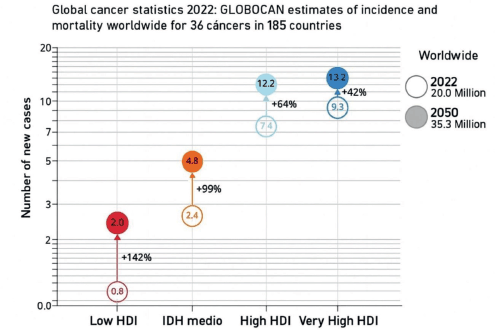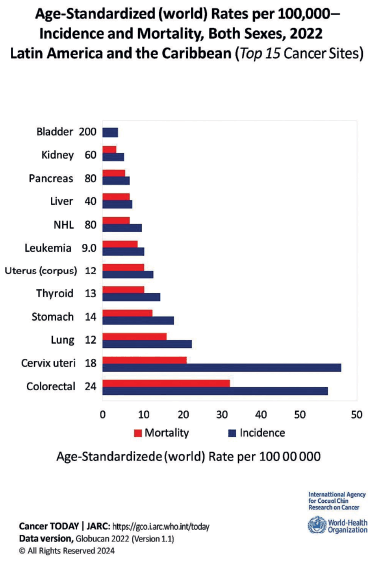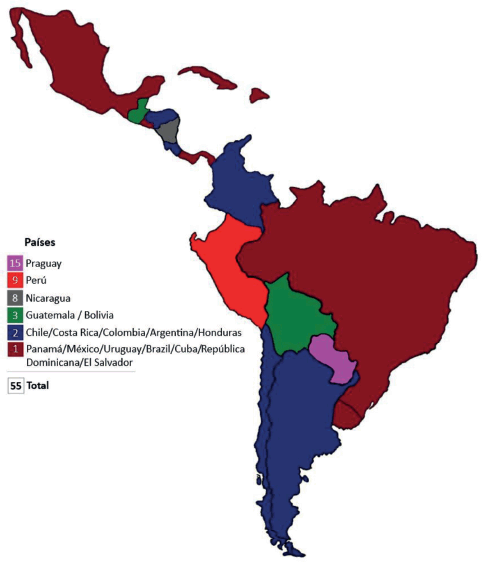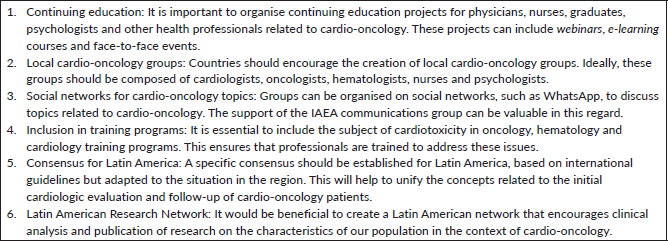Cardio-oncology in Latin America and the Caribbean. Current state
Manuel Bazan1, Claudia Gutiérrez-Villamil2, Amalia Peix3, Saurabh Malhotra4, Fernando Dettori5, Roberto N Agüero5, Belén Flores6, Claudio Tinoco Mesquita7, Enrique Hiplan8, Teresa Massardo9, Isabel Berrocal10, José A Coss11, Verónica Gómez12, María C Fonseca13, Karla Abadí14, Adriana Puente15, Víctor Rosales16, Luis F Chen17, Yariela Herrera18, Marina Arnal19, Aurelio Mendoza20, Omar Alonso21, Jorge E Aguiar3, Carla Cueva22, Enrique Estrada23 and Diana Páez23
1Cardio-Oncology Service, Institute of Oncology and Radiobiology, Havana, Cuba
2Nuclear Medicine Service, Fundación Cardioinfantil-La Cardi, Bogotá, Colombia
3Institute of Cardiology and Cardiovascular Surgery, Havana, Cuba
4Division of Cardiology, Cook County Health, Chicago, IL, USA
5Nuclear Medicine, National Atomic Energy Commission, Buenos Aires, Argentina
6Bolivian Nuclear Energy Agency (ABEN), Nuclear Medicine Center, El Alto, Bolivia
7Antonio Pedro University Hospital, Niteroi, Rio de Janeiro, Brazil
8Clinical Nuclear Medicine Service, Base Hospital of Valdivia, Los Ríos, Chile
9Universidad de Chile, Hospital Clínico, Santiago, Chile
10San Juan de Dios Hospital, Caja Costarricense de Seguro Social, San José, Costa Rica
11Rosa Emilia Sanchez de Tavares National Cancer Institute (INCART), Santo Domingo, Dominican Republic
12Hospital Oncológico del ISSS, San Salvador, El Salvador
13Roosevelt Hospital, Guatemala City, Guatemala
14San Felipe General Hospital and Asilo de Inválidos, Tegucigalpa, Honduras
15Centro Medico Nacional 20 de Noviembre, ISSTE, CDMX, Mexico
16National Autonomous University of Nicaragua (UNAN), Roberto Calderón Gutiérrez Public Hospital, Managua, Nicaragua
17National Oncology Institute, Panama City, Panama
18Santo Tomás Hospital, Panama City, Panama
19La Costa Medical Center, Asuncion, Paraguay
20National Cardiovascular Institute INCOR, Lima, Peru
21Nuclear Medicine Center, Hospital de Clínicas, Montevideo, Uruguay
22Latin America and the Caribbean Division, Department of Technical Cooperation, International Atomic Energy Agency, Vienna, Austria
23Nuclear Medicine and Diagnostic Imaging Section, Division of Human Health, Department of Nuclear Sciences and Applications. International Atomic Energy Agency, Vienna, Austria
Abstract
Health problems in the Latin American and Caribbean (LAC) region are mainly associated with noncommunicable diseases, with cardiovascular disease and cancer being the leading causes of death. However, knowledge and training opportunities in cardio-oncology, as well as active cardio-oncology groups, are mainly limited to large academic institutions or isolated private groups. To contribute to the implementation of viable strategies to ensure equitable access to care for all, it is essential to understand the current situation. This publication assesses the epidemiological situation of cancer in LAC and discusses the development of cardio-oncology in the region. It analyses the results of the survey on knowledge and medical action in cardio-oncology carried out among a group of physicians involved in the care of oncology patients and proposes recommendations based on the results obtained.
Keywords: cardio-oncology, cardiotoxicity, multimodality imaging
Correspondence to: Manuel Bazan and Claudia Gutiérrez-Villamil
Email: bazanmilianm@gmail.com
Published: 17/10/2025
Received: 23/03/2025
Publication costs for this article were supported by ecancer (UK Charity number 1176307).
Copyright: © the authors; licensee ecancermedicalscience. This is an Open Access article distributed under the terms of the Creative Commons Attribution License (http://creativecommons.org/licenses/by/4.0), which permits unrestricted use, distribution, and reproduction in any medium, provided the original work is properly cited.
Introduction
Health problems in the Latin America and Caribbean (LAC) region are mainly associated with noncommunicable diseases (NCDs) [1, 2].
Increased life expectancy, as well as inter-related factors such as globalisation, urbanisation, the increase in diabetes mellitus, inadequate diet, obesity and physical inactivity, contribute to cardiovascular diseases (CVD) being the leading cause of death in the world [3].
On the other hand, globally cancer is the second leading cause of mortality, causing almost 10 million deaths in 2022 (Figure 1), which represents approximately double the figure in 1990 [4]. It is estimated that 40% of cancers can be prevented through healthy lifestyles and that one third of cancers can be diagnosed in their early stages of development through early detection programs [3].
Since the 1950s, the concept of a cure for cancer emerged, which became a reality in the 1990s with the appearance of specific treatments [4]. Since then, there has been talk of a reduction in cancer mortality, but this has been accompanied by increased cardiovascular morbidity and mortality in cancer survivors due to cardiotoxicity [5].
CVD and cancer combined accounted for 65% of all premature deaths [6].
Despite advances in diagnosis and treatment, CVDs remain the leading cause of death in women worldwide. According to the World Heart Federation, CVDs, which include heart disease and stroke, are the most common NCDs worldwide, responsible for nearly 20.5 million deaths. Alarmingly, more than 75% occur in low- and middle-income countries [7]. CVD is responsible for 35% of women's deaths each year, exceeding the rate of breast cancer by more than 13 times, greater than all cancers combined [7] (Figure 2).
It is known that breast cancer and CVD share risk factors, such as: age, diet, family history, alcohol consumption, hormone replacement, obesity/overweight, physical inactivity and tobacco use [8, 9]. Although breast cancer is not a reproductive milestone per se, treatment often alters reproductive function and compromises ovarian hormone production.
Cardio-oncology has emerged as clinical awareness of the broad cardiovascular implications of cancer and its treatments has grown. In a cohort from the Surveillance, Epidemiology and End Results cancer registry that included women with definitive treatment for localised breast cancer and who were alive 5 years after their initial diagnosis, the cumulative incidence of non-breast cancer mortality was almost seven times greater than the cumulative incidence of breast cancer mortality. CVD was the most common cause, affecting 30% of women [9].

Figure 1. Comparison of new reported cases of cancer between the different groups of countries according to the Human Development Index and the estimated 2050.

Figure 2. Main cancer localisation sites. It can be seen that breast cancer in women and prostate cancer in men have the highest morbidity and mortality rates.
Currently, there is an exponential growth of CVD in cancer patients, related to their longer survival and the use of oncological therapies that produce cardiovascular toxicity, which further increases the risk of CVD. This has prompted a multidisciplinary and novel approach in the field of cardio-oncology. The goal is to reduce CVD morbi-mortality resulting from the cardiotoxicity of oncology treatment. To achieve this, oncology patients' cardiovascular health is assessed comprehensively before starting treatment and their potential cardiotoxicity is monitored during and after oncology therapy. In addition, the aim is to ensure that the patient receives the first-line treatment for his or her disease. In this context, terms such as ‘preventive cardio-oncology’ and ‘permissive cardiotoxicity’ have been coined [10, 11].
In addition to the traditional link between the adverse effects of cancer therapies and cardiovascular health, the concept of ‘reverse cardio-oncology’ is emerging. This burgeoning field shifts the perspective by examining how CVD may influence the onset and progression of cancer. An increased likelihood of developing cancer has been observed in patients with pre-existing cardiovascular conditions, attributed to shared risk factors such as obesity, sedentary lifestyle and smoking. Underlying mechanisms such as chronic inflammation and clonal hematopoies is shed further light on the connections [7].
LAC are no strangers to the situation described above; however, the approach to the problem is at different stages. Multidisciplinary cardio-oncology groups have been established in some countries, but the current number is still insufficient and there is no regional approach [12]. This publication describes the epidemiological situation of cancer, as well as the state of development of cardio-oncology in the region.
Epidemiology in LAC
The leading causes of death in the region in 2019 did not differ significantly from those in high-income regions, according to data from the World Health Organisation (WHO). CVD and cancer predominated, followed by stroke, Alzheimer's and other dementias, as well as chronic obstructive pulmonary disease [13].
In 2022, life expectancy in LAC, according to the Statista Research Department (2023), was 77 years for women and 70 years for men. In addition, South America had the highest sub-regional life expectancy, reaching 78 years for women and 71 years for men [14].
In 2019, the age-standardised mortality rate for cancer was estimated at 115.7 deaths per 100,000 population (excluding non-melanoma skin tumours) (Figure 2). This rate varied from country to country from 155.2 deaths per 100,000 population in Grenada to 68.7 deaths per 100,000 population in El Salvador. In most countries, age-standardised mortality rates for cancers are higher in men than in women, except in Bolivia, Guyana and El Salvador. Four types of malignant tumours appear in the list of the 15 leading causes of death: lung, colon and rectum, breast and prostate cancer [15].
Oncologic diseases in 2019 were responsible for 31.0 million years of life lost due to premature death (YLL), equivalent to 3,072 years per 100,000 population. The number of DALYs increased from 25.2 million years in 2000 to 31.0 million years in 2019. The top five cancer types that impacted DALYs were lung, breast, colon and rectal cancer, leukemia, lymphomas and multiple myeloma [16].
On the other hand, the LAC region has made significant progress in macroeconomic resilience over the last three decades. According to the World Bank report, the regional Gross Domestic Product (GDP) grew by 2.0% in 2023, slightly above the 1.4% previously projected [15]. However, these macroeconomic achievements did not translate into an increase in medical research in the region. Currently, only 0.65% of GDP is allocated to medical research and the region participates in only 5% of global cancer therapy clinical trials [13].
Current status of cardio-oncology in LAC
A narrative summary was made of the epidemiology of cancer in the region during the last 5 years. Only three countries have national cancer incidence and mortality registries: Uruguay, Cuba and Costa Rica. Therefore, WHO and Pan American Health Organisation (PAHO) registries were used.
LAC show varying degrees of development of cardio-oncology, despite the support provided by the Ibero-Latin American Society of Cardio-oncology (iLACO) and the International Society of Cardio-oncology (IC-OS). This development has been limited to isolated groups in academic centers. However, Brazil and Argentina have made greater progress and have published national guidelines on the subject [17–20].
Professionals recognise the usefulness of multimodality cardiac diagnostic imaging in the evaluation of oncology patients before, during and after specific treatment for early detection of cardiotoxicity [21].
No hay ninguna fuente en el documento actual.). It is important to review the possibilities of radiological and nuclear techniques, considering the variability in the availability of the recommended technology between countries and even between different geographical areas of the same country [22].
European cardio-oncology guidelines recommend the use of echocardiography, especially 3D and longitudinal Strain Global to assess these patients. Cardiac magnetic resonance, is the second option, although its access is limited due to its high cost and lack of trained personnel. Isotopic ventriculography (ERNA) is an indication II-C, although it is a valid and necessary alternative in cases of poor ultrasound window due to its high reproducibility [21], but it is little used except in Panama, where its use predominates, and in El Salvador and Cuba in selected cases. In other countries, a low volume of requests for ANRT has been reported. Although atherogenesis is described among the cardiotoxic side effects of radiotherapy [23], where the role of myocardial perfusion (PM SPECT) is very useful in the early detection of ischemic coronary artery disease, its use in this type of patient is scarce.
Although regional cancer registries are considered for national statistics by sources such as Globocan and organisations such as PAHO, not all countries have national cancer registries due to high logistical costs. In addition, these registries are usually general statistical data, so they do not collect detailed information on diagnosis, treatment or toxicities [24]. At this point, we would like to highlight the Obelisco registry,
carried out by the Cardio-oncology Council of the Argentine Society of Cardiology, the first registry we know of on cardiotoxicity in Latin America [25]. However, to address this limitation, the Global Cardio-Oncology Registry, a prospective, multicenter, multinational registry that collects information on cardiotoxicities due to oncospecific treatments, has been created [26].
As part of the International Atomic Energy Agency (IAEA) technical cooperation project for LAC, RLA6093: Strengthening regional capacities for the use of nuclear medicine techniques in a multimodal cardio-oncology approach in cancer patients (ARCAL CXCIII), a survey was carried out among the countries participating in the project to evaluate the current state of cardio-oncology in each country, considering a description of the situation during the first semester of 2024. Seventeen countries responded: Argentina, Brazil, Bolivia, Colombia, Chile, Costa Rica, Cuba, Dominican Republic, El Salvador, Guatemala, Honduras, Mexico, Nicaragua, Panama, Paraguay, Peru and Uruguay.
Survey analysis
The survey was answered by 55 professionals from the 17 countries included (Figure 3). Eighty-five percent of the participants were oncologists and cardiologists, while 11% were specialists in internal medicine. Most of these specialists work in general public hospitals (63.6%).

Figure 3. Number of respondents by countries participating in the survey.
Only 34% report having a cardio-oncology service or group, which is explained by the lack of training of professionals in this field, as well as insufficient human and material resources and infrastructure.
Comprehensive cardio-oncologic evaluation before, during and after oncospecific treatment is reported in 16% of the respondents. The rest indicated that it is not performed frequently or only occasionally, which prevents us from obtaining a global stratification of cardiovascular risk and establishing measures for adequate primary prevention.
Patients are generally referred to cardiology when their treating physician (oncologist or hematologist) detects the presence of cardiovascular risk factors (40%), for a history of coronary artery disease (23.6%), as part of an institutional protocol or according to the planned therapeutic scheme (32%). The majority of respondents use the international guidelines of the related scientific societies, the most widely used being those of the American Society (ASCO) + European Society of Oncology (ESMO) in 27.2%. European cardio-oncology guidelines are used exclusively by 16.3%.
A high prevalence of breast, prostate, colon, lung and leukemia cancers was identified, coinciding with the statistics published by WHO. The usual treatment is surgery, chemotherapy and radiotherapy [27].
Eighty-four percent of respondents report the use of biomarkers for the detection of cardiotoxicity, the most commonly used being troponin and brain natriuretic peptide.
Echocardiography is the most widely used method to assess ventricular function (93%) and practically all consider it to be the fastest access diagnostic method. The most commonly used protocol for cardiotoxicity assessment is the 2D mode (47.2%). There was a low use of the global longitudinal strain measurement. Echocardiogram prior to potentially cardiotoxic treatment is performed in 31% of cases, only when there is any history in 15% of cases, while it is not performed in 2% of cases. The follow-up echocardiogram was performed depending on the scheme in 58% and according to evolution in 29%.
Isotopic ventriculography studies (ERNA) are used in case of doubts or discrepancies; it is considered among the options in 45.4%, while 5.4% report it as the only option. Myocardial perfusion studies (PM SPECT) are only performed when coronary artery disease is suspected. Myocardial ischemia is detected in approximately 15% of these patients.
Cardioprotection is indicated in most patients (65.5%) with one of the existing schemes.
The use of liposomal anthracyclines is not widely used due to their high cost and/or lack of coverage in the health system.
A high percentage (65.5%) consider that training for evaluation and detection of cardiotoxicity is insufficient or absent. Only one professional considers that he/she has expert training. There is little access to formal education in cardio-oncology in 62% and no access at all in 22%. Only 14.5% reported being very accessible.
Recommendations
Table. Recommendations

Conclusion
Improvements in cancer treatments, increased survival rates and the potential for cardiac side effects of these treatments have led to greater collaboration between: oncology, cardiologists and hematologists, as well as the development of cardio-oncology clinics. This collaboration is important because these specialists ensure greater patient satisfaction, assist physician teams in making complex treatment decisions and diagnose cardiac complications early.
Cardio-oncology in LAC works in isolated groups and with diverse developments. We hope that, in the coming years, thanks to compliance with these recommendations and the support of organisations such as the IAEA, we will achieve uniform development throughout the region and the incorporation of the different cardio-oncology societies and working groups into international societies such as SIAC, iLACO and IC-OS, which will allow us to position ourselves in this increasingly important and necessary area, both in our countries and in the region, to promote the development of this new subspecialty.
Conflicts of interest
We have no conflicts of interest.
Funding
No funding has been received for the preparation of the manuscript.
References
1. Da Ros, Lucas U, and Oliveira D, et al (2025) Social and health disparities associated with healthy brain ageing in Brazil and in other Latin American countries Lancet Glob Health 13(2) e277–e284 https://doi.org/10.1016/S2214-109X(24)00451-0
2. Flores YN, Bastos JLF, and Caballero T, et al (2025) The role of demographic and epidemiologic transitions on growing health expenditures in Latin America and the Caribbean: a descriptive study Lancet Reg Health Am 44 100684
3. Gaidai O, Cao Y, and Loginov S (2023) Global cardiovascular diseases death rate prediction Curr Probl Cardiol 48(5) 101622 https://doi.org/10.1016/j.cpcardiol.2023.101622 PMID: 36724816
4. Lin L, Li Z, and Yan L, et al (2021) Global, regional, and national cancer incidence and death for 29 cancer groups in 2019 and trends analysis of the global cancer burden, 1990–2019 J Hematol Oncol 14 1–24 https://doi.org/10.1186/s13045-021-01213-z
5. Afrasiabi K, Linskey ME, and Zhou YH (2020) Exploiting cancer’s tactics to make cancer a manageable chronic disease Cancers (Basel) 12(6) 1649 https://doi.org/10.3390/cancers12061649
6. Snipelisky D, Park JY, and Lerman A, et al (2017) How to develop a cardio‑oncology clinic Heart Fail Clin 13(2) 347–359 https://doi.org/10.1016/j.hfc.2016.12.011
7. Abdullahi ZM, et al (2025) Epidemiology, prevention and management of non‑communicable diseases (NCDS): a review J Health Wellness Safety Res
8. Stuenkel C (2024) Reproductive milestones across the lifespan and cardiovascular disease risk in women Climacteric 27(1) 5–15 https://doi.org/10.1080/13697137.2023.2259793
9. Mehta LS, Watson KE, and Barac A, et al (2018) Cardiovascular disease and breast cancer: where these entities intersect: a scientific statement from the American Heart Association Circulation 137(8) e30–e66 https://doi.org/10.1161/CIR.0000000000000556 PMID: 29437116 PMCID: 6722327
10. Madhav K, Fan J, and Hyslop T, et al (2023) Relative burden of cancer and non‑cancer mortality among long‑term survivors of breast, prostate, and colorectal cancer in the US JAMA Netw Open 6(7) e2323115 https://doi.org/10.1001/jamanetworkopen.2023.23115
11. Murthy SS, Trapani D, and Cao B, et al (2024) Premature mortality trends in 183 countries by cancer type, sex, WHO region, and World Bank income level in 2000‑19: a retrospective, cross‑sectional, population‑based study Lancet Oncol 25(4) https://doi.org/10.1016/S1470-2045(24)00274-2
12. Al Sukhun SA, Vanderpuye V, and Taylor C, et al (2024) Global equity in clinical trials: an ASCO policy statement JCO Glob Oncol 10 e2400015 https://doi.org/10.1200/GO.24.00015
13. Resource‑New P (2024) Cardio‑oncology: enduring impacts of cancer treatments Nursing 18 20
14. Peix A, Bazan M, and Aguiar JE, et al (2024) How international organizations can support the development of cardio‑oncology in the Latin American and the Caribbean region Eur Heart J Imaging Methods Pract 2(1) qyae005 https://doi.org/10.1093/ehjimp/qyae005 PMCID: 11195709
15. Takala J, Hämäläinen P, and Lauriola M, et al (2024) Global, regional and country‑level estimates of the work‑related burden of diseases and accidents in 2019 Scand J Work Environ Health 50(2) 73 https://doi.org/10.5271/sjweh.4132 PMCID: 10927068
16. González Maciel J, Del Valle E, and Lutz C (2024) Health predictions in Latin America J Insur Med 51(1) 17–24 https://doi.org/10.17849/insm-51-1-17-24.1
17. Lyon AR, López‑Fernández T, and Couch LS, et al (2022) 2022 ESC guidelines on cardio‑oncology developed in collaboration with EHA, ESTRO and IC‑OS: developed by the task force on cardio‑oncology of the European Society of Cardiology Eur Heart J 43(41) 4229–4261 https://doi.org/10.1093/eurheartj/ehac244
18. Bazan M, Mestre BF, and Peix A (2021) Cardio‑Oncology in Cuba: The Present and the Future (Washington, DC American College of Cardiology) pp 162–164
19. Daniele AJ and Gregorietti V (2020) Cardio‑Oncology in Argentina: Past, Present, and Future (Washington, DC: American College of Cardiology) pp 336–339
20. Mundnich S and Saba MM (2022) Cardio‑oncology in Chile: the future of an emerging discipline Cardio Oncol 4(4) 555–558
21. Ruiz‑Mori E, Ayala‑Bustamante LE, and Quispe‑Silvestre E, et al Cardio‑Oncology in Peru: An Emerging Discipline (Washington, DC: American College of Cardiology) pp 671–673
22. Mikail N, Chequer R, and Imperiale A, et al (2023) Tales from the future‑nuclear cardio‑oncology, from prediction to diagnosis and monitoring Eur Heart J Cardiovasc Imaging 24(9) 1129–1145 https://doi.org/10.1093/ehjci/jead168
23. Petit C, Escande A, and Sarrade T, et al (2023) Radiation therapy in the thoracic region: radio‑induced cardiovascular disease, cardiac delineation and sparing, cardiac dose constraints, and cardiac implantable electronic devices Cancer Radiother https://doi.org/10.1016/j.canrad.2023.06.027
24. Burkhardt B (2024) What can we learn from cancer registries? Haematologica 109(3) 716 https://doi.org/10.3324/haematol.2023.284104
25. Makhoul‑Mtsac SS, et al (2022) OBELISCO‑SAC registry Rev Argent Cardiol 90 452–461 http://dx.doi.org/10.7775/rac.es.v90.i6.20575
26. Teske AJ, Moudgil R, and López‑Fernández T, et al (2023) Global cardio‑oncology registry (G‑COR): registry design, primary objectives, and future perspectives of a multicenter global initiative Circ Cardiovasc Qual Outcomes 16(10) e009905 https://doi.org/10.1161/CIRCOUTCOMES.123.009905
27. Piñeros M, et al (2022) An updated profile of the cancer burden, patterns and trends in Latin America and the Caribbean Lancet Reg Health Am 13 100336





